
by Tina Chow and Sean Dooley
The term geologic or natural hazard implies that some force of nature is threatening society and its settlements in some shape or form. Earthquakes, volcanoes, landslides, mudflows, erosion, deposition, seismic sea waves, land subsidence, wave action, avalanches, glaciers, are all hazards, yet earthquakes are clearly the most destructive, short term natural forces on our planet. This chapter will look at some of these natural hazards and examine their impact upon society. Particularly, this chapter will focus on those disasters that are the result of plate tectonics, namely, earthquakes and volcanoes. Most of these two natural hazards occur in a wide belt circling the Pacific Ocean, known as the Ring of Fire. It is known by this name because of the hotbed of geological activity that takes place there. Most of the world's tectonic plates meet and collide at this area of the earth. We will also look briefly at flooding and storms.
These images taken from the US Geological Society's Webpages are of Mount Helenes. Click on the images to see bigger versions.
Volcanoes
Volcanoes, plainly, are hotspots or openings on the Earth's surface that lead to the magma and rocks underneath the earth's surface. Several different kinds of volcanoes exist, but the two most notable kinds are composite volcanoes and cinder cone volcanoes. The most famous, the most spectacular, and the most beautiful volcanoes in the world are composite volcanoes . They are composed of layers of ash, cinder, and lava and tend to have steep slopes that form a peak or summit at the top. They also tend to be the largest kind of volcanoes. Cinder cone volcanoes are shaped in a circular plan with steep slopes. They are formed from cinder and from volcanic rock fragments. Although they are numerous, they are usually not as large as composite volcanoes. A third type of volcano, called dome volcanoes, has bumps or holes in the basins of craters.
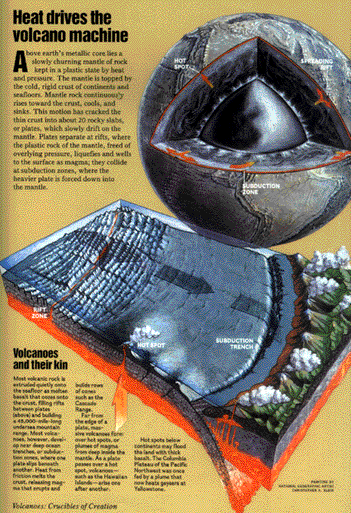
How are Volcanoes Formed?
Volcanoes are formed on the earth’s surface where molten rock has escaped to penetrate the crust. These places are known as hotspots by the scientific community. These are areas of intense volcanic activity, usually formed by the movement of crustal plates. The most common place for volcanoes to form is along subduction zones. These zones are places where one tectonic plate is being overridden by another tectonic plate as it moves downward in the asthenosphere. The descending plate often melts under the extreme temperature and pressure and the lighter chemicals found within the plate force their way to the surface. These fractions, as they are called, provide the molten rock for volcanic eruptions.
What comes out of them and why?
Volcanoes erupt several different materials, the most notable of which is flowing lava. This lava starts out as magma, or melted rock, below the earth's surface. When this melted rock is subjected to extreme pressures and temperatures, it is forced toward the surface because it is less dense than the rock that surrounds it. Water vapor is also released by erupting volcanoes, as well as many poisonous gases. Mudflows sometimes form on the slopes of volcanoes where volcanic ash and dust may mix with water and snow to form flows that might stretch for miles. When conditions are right, such as when enough pressure from the gases trapped inside the volcano has built up or when an earthquake occurs, a volcano eruption is imminent. Some volcanoes lay dormant for hundreds of years, erupting only occasionally, and some may erupt only once and become what is known as an extinct volcano.
How dangerous are they?
Volcanoes have long been considered by civilizations to be the harbingers of death and destruction. This is by no means a falsehood. People have often been drawn to the fertile soils that can be found near areas of volcanic activity, yet we know from events like Pompeii and Krakatoa that volcanoes are very dangerous and unpredictable and have caused the loss of thousands of lives.
Some examples
Pompeii Mount Vesuvius, overlooking, the ancient Roman city of Pompeii, erupted with ferocity in the year 79 A.D. Ash and mudflow from the erupting volcano covered the town quickly. Many of the inhabitants escaped but most were suffocated by the poisonous and noxious gases that the volcano emitted or buried alive by the falling ash, pumice, and mudflows. Since that great disaster Mount Vesuvius has erupted several more times, but never as spectacularly.
In the year 1883 the island of Krakatoa suddenly explode and became one of the most famous volcanic explosions the world has ever known. An earthquake on May 20th of that year set off a chain of events that kept the volcano erupting ash and cinder, as well as exploding violently, straight into the summer months. On August 27, 1883, Krakatoa exploded with a ferocity that know one had ever seen before. The explosion caused tsunami's, also known as tidal waves, to reach neighboring islands, causing the loss of tens of thousands of lives.
The United States is not without its own major volcanic eruptions. When it erupted in 1980, Mount St. Helen's caused more than 1.5 billion dollars in damage and may have killed 100 or more people. The resulting floods caused by the explosion overflowed rivers and caused massive destruction to nearby railroads and houses.
What uses do volcanoes have?
Our ancestors were attracted were attracted to volcanoes because with them came naturally heated springs and rich fertile soil suitable for early agricultural societies. Even now they are not without their uses. They can still be used for the above mentioned purposes. As the world begins to search for new energy sources to replace our rapidly diminishing fossil fuel supplies, scientist are beginning to look at geothermal energy as a viable source of power. Power companies can already provide people with energy converted from the natural steam found in volcanic areas.
Storms
This eye of a storm is of Hurricane Angela. Look at the end of the paper for a link to the site I took this from.
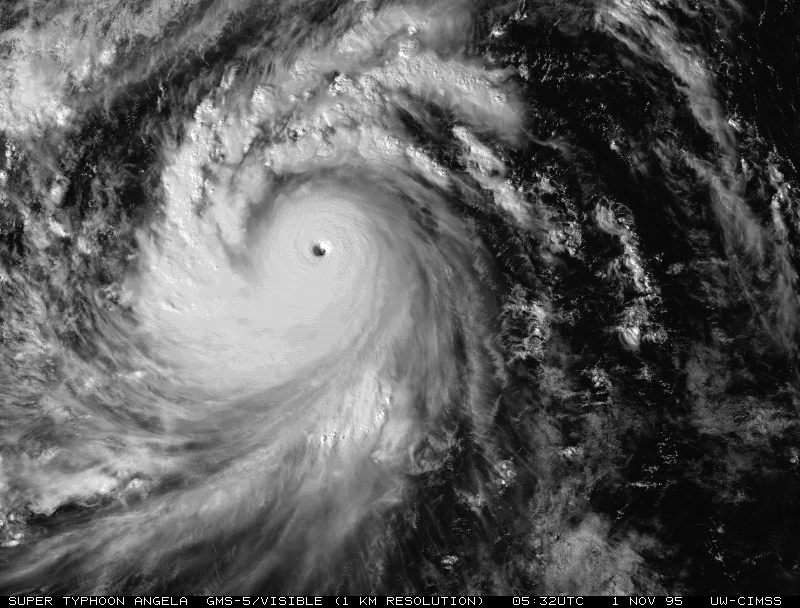
Several different kinds of storm systems exist. Briefly, this chapter is going to examine some types of storms and why they are considered natural hazards. Hurricanes While tropical storms are not as large as frontal storms, they are nonetheless the deadliest storms on earth. Hurricanes are formed in the late summer months when rays from the sun heat the air and water out in the ocean, evaporation and conduction transfer heat to the atmosphere so rapidly that air and water temperatures hardly differ by more than 2 degrees Fahrenheit.This mixture of heat and moisture, when mixed with a westerly flowing wind, can generate a storm of colossal proportions by the time it reaches the East Coast of the United States or the Caribbean. And similar storms around the world, such as typhoons, can cause the same effect on other regions. The damage done by hurricanes is readily apparent. The Southern States have been ravaged in recent years by tropical storms that have spun out of control. Miami was devastated on August 24, 1992, when violent Hurricane Andrew caused billions of dollars of damage and the loss of hundreds of lives. Tornadoes Typical tornadoes are found lying in thunderstorms. They are formed when strong low-pressure centers suck rotating winds inward, causing a spiraling effect which gives the tornado its power. They are most dangerous when they reach the ground because of their ability to suck objects up and toss them hundreds, maybe thousands of yards. They eventually dissipate because debris they pick up from the ground eventually interferes with the airflow and causes them to fade.
Floods

This illustrates how society can be affected by floods. You can see how itcan impede transportation and cause destruction. A link to the site where I took this from can be reached through a link at the end of the paper.
Flooding from inland rivers is a natural disaster whose risk has commanded the most systematic and explicit public assessment over the longest period of time in the United States. Any unregulated stream has its peaks in its hydrograph that cause overbank flow with a magnitude and recurrence interval that can be estimated with degrees of accuracy dependent upon the quality of streamflow records and of method. The government can and does take steps to minimize damage done by flooding but unknown factors can always contribute to flooding. Volcanoes, hurricanes, severe storms, and earthquakes can all cause major flooding and property damage to occur.
Earthquakes
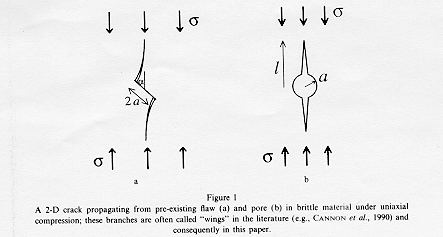
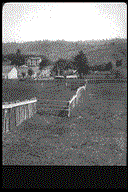
The first two pictures are taken from Berkley's Geology Department Webpages and the third picture is taken from a site at the University of Virginia.
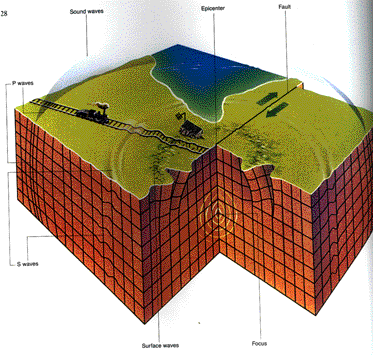
What are they?
Earthquakes occur when two tectonic plates are trying to move amongst one another but are prevented from doing so because of a snag between bends of rock. Pressure is built up when the two plates try to move past each other. Eventually the energy that gets built up is released and creates vibrations. These vibrations cause massive destruction when they produce a large amount of tremors. Hundreds of small earthquakes occur deep below the surface that cause vibrations so slight that we do not feel them. The earthquake essentially starts at the focus where tension is released at the fault. As the rock begins to snap back to its original shape, it releases violent vibrations. The surface directly above the origin of the quake is called the epicenter. That is the point from which vibrations are radiated in all directions, causing the destruction. The closer you are to the epicenter, the stronger the vibration is. Damage is more severe near the epicenter of an earthquake.
Seismic Waves
Primary waves are the first waves to arrive at the surface since they are the fastest. These are the first waves registered by the seismometers. These primary waves are compression waves which means that it pushes and pulls the medium of travel in the direction of the wave's journey. The secondary waves are transverse shear waves that move almost half as slow as P-waves. S- waves as they are called for short, move the ground up and down or from side to side. Surface waves vibrate the ground sideways. Surface waves travel much slower than P-waves and S-waves. Surface waves die out more slowly and so they can travel far from the epicenter to affect structures. P waves travel similarly to sound waves by moving back and forth causing the air to move when they leave Earth's surface. Hence you can sometimes hear P-waves, which can be quite loud. P-waves can be illustrated by performing a little experiment. Take a Slinky and stretch it horizontally on the floor, pulling the ends away from each other. Now push one end quickly towards the other then pull it back to its' original position. The resulting wave pattern is a model of how P- waves travel through rock. The Slinky example can also be used to illustrate S-waves, except instead of pushing the end forward, you move the end side to side, demonstrating how S-waves travel along the surface. P-waves move about 15,000 miles per hour, while S-waves move about 9,000 miles per hour. These waves travel great distances, but when they reach the distance103 degrees away from the focus, there is a shadow zone that waves do not reach. Two major types of surface waves are Rayleigh waves and Love waves. Rayleigh waves radiate vibration. Love waves are also known as longitudinal waves and vibrate horizontally at right angles to the direction of wave travel. Surface waves do most of the damage that coincide with earthquakes. Surface waves are also the most audible. These waves have the longest periods and are the slowest. The seismic waves with the longest periods occur when the rebound or slip between the two plates is slow. The shorter period waves occur when there is a faster slip and can often be heard. Some coincide with the resonance frequency of the Earth and can be heard for periods longer than a week. Faults Faults are adjustments of the crust by the Earth. Most faults occur at the boundary of two plates. There are two types of faults. One type is called the strike-slip fault. That is when two plates slide past each other. The San Andreas Fault is the most famous of the strike-slip faults. The second is the dip-slip fault. This category includes normal faults, reverse faults, and oblique faults. The normal fault is when one side slides downward past the other. The reverse fault is when one side is pushed above the other. The reverse fault is called a thrust fault if the plane is flat and the movement is horizontal. If a fault consists of both vertical and horizontal movements, it is called an oblique fault.
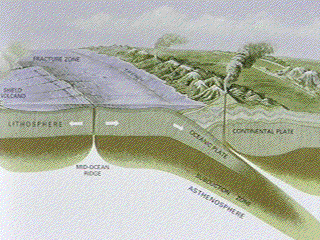 This diagram
illustrates how slips work.
This diagram
illustrates how slips work.
How are earthquakes classified?
Earthquakes are classified by their magnitudes. A magnitude is the total amount of energy released by the earthquake. Scientists generally use two different scales to measure the magnitude of earthquakes. The first and most famous of these is the Richter Scale, developed byCharles F. Richter in 1935. The Richter scale measures the energy released at the focus of the earthquake. The Richter scale measures earthquakes with the help of a seismograph. First the maximum amplitude of the earthquake vibrations is determined. Then it is divided by the degree of amplification found by the seismograph to get a true reading. After making adjustments for the dissipation of vibration as the waves travel from the focus to the seismograph station, you arrive at the measurement. The scale is logarithmic in nature and runs from 1.0 to 9.0. So an earthquake with a magnitude of 7 would be 10 times more powerful than an earthquake with a magnitude of 6 and so on. It is precisely because of this principle that we can disprove the notion that a couple of smaller earthquakes will help distribute the tension of the plates enough to offset a big earthquake. It would take tens of smaller ones to counter a big one. A magnitude can be expressed in whole numbers and decimals. Magnitude readings can help scientists measure the severity of an earthquake. A reading of 2.0 or less on the Richter Scale are usually considered to be harmless and thus given the term micro- earthquakes. These tend to be localized vibrations not commonly felt by people. Thousands of earthquakes of a magnitude of 4.5 or greater are quite common every year and they tend to be given thought of as moderate events. Earthquakes with a magnitude of 8.0 or higher are considered to be Great Earthquakes. These tend to be particularly devastating in nature, both economically and environmentally.
The Mercalli scale for measuring earthquakes is also used to day. This scale is different from the Richter Scale in that it doesn’t measure the amount of energy released during tremors, it only measures the visible effects of an earthquakes. Known as Mercalli intensity, earthquakes are given a rating of I-XII in Roman Numerals. A rating of IV would indicate those vibrations on might feel from a passing train while a rating of X could cause numerous buildings to collapse.
Another way for scientists to measure the seismic moment of an earthquake. Roughly defined, the seismic moment is the product of the average amount of slip(the measure of how fast movement occurs along a fault), the area of the rupture and the shear modulus(strength) of the rocks.
What are the effects of earthquakes?
Tsunamis are one type of side effect caused by an earthquake. When an underwater earthquake occurs, the vertical displacement causes ripples on the surface similar to those created when a stone is thrown in the water. These waves, though several hundred miles long and moving between 300 and 600 miles per hour, are only a few feet high. They pass unnoticed by ships, but once they approach land, a wall of water up to 200 feet high is formed and crashes on land. Tsunamis are unnoticed out in the ocean because the water is very deep, but once they approach land, the wave has no where to go but up, thereby producing the huge wave.
This is the aftermath of a tsunami taken from slides on the USGS' webpages.
Earthquakes can trigger inactive volcanoes that can erupt. They can also trigger landslides that cause destruction as well. Aftershocks of the earthquakes can be just as deadly as the first occurrences. Sometimes one can observe lights when an earthquake occurs. A dome shaped pattern forms close to the ground. When friction heats the interfaces between plates, water there vaporizes and creates an electric field that is responsible for this phenomena.
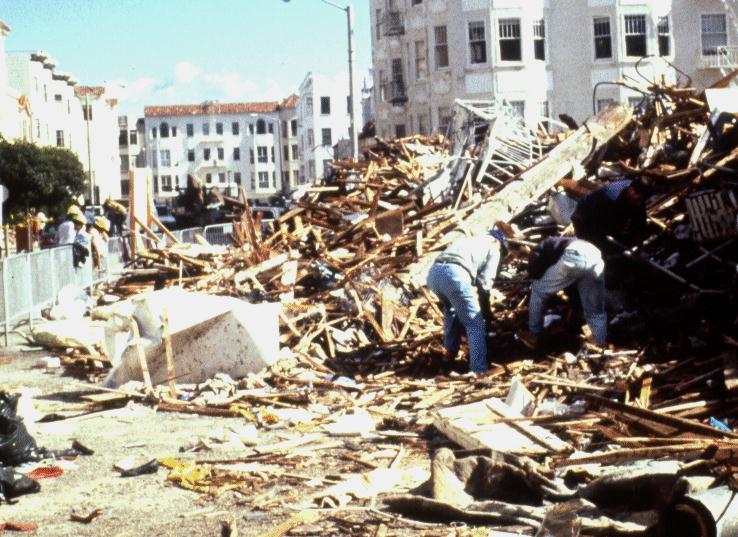
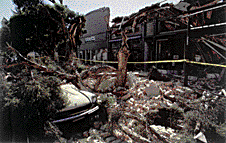
An earthquake can have drastic consequences for the economy. Earthquakes can cause massive damage to societies in the form of deaths and destruction of man-made structures. As a result, affected people have to draw upon their savings to help restore the chaos. Savings are pulled out of the stock market and other investments such as bonds. This sudden decrease in demand for investments can make their value go down sharply leading to huge recessions. The earthquake that took place in Kobe Japan recently is a good example of how destructive an earthquake can be. It left thousands of people homeless and caused billions of dollars in damage, sending ripples even to the stock markets of the West. Earthquakes can have disastrous effects on the world and local economies wheredestruction they happen. Below are a few examples od just the kind of that individual earthquakes have caused:
San Francisco
San Francisco sits close to the San Andreas and other faults. It was widely known as Earthquake city by its inhabitants for many years in the nineteenth century. In 1906, one of the greatest earthquakes ever to hit that area occurred. The great quake. It measured 8.2 on the Richter Scale and tremors lasted as long as 40 seconds. Destruction was everywhere. The fires that resulted from the earthquake engulfed 500 city blocks and left as many as 3,000 dead or missing. The city literally had to rebuild itself from the ashes. In 1989 another earthquake struck the area. The Loma Prieta Earthquake caused as much as $10 billion and left as many as 67 people dead.
Mexico City
Mexico City suffered a great earthquake late in the summer of 1985. The earthquake is reported to have killed over 8,000 people and injured up to 30,000. Almost 500 buildings in Mexico City destroyed and damage was estimated at $4 billion dollars.
Japan
Japan has had some of the most widely known natural disasters to occur there in history. The 1923 earthquake in tokyo left over 100,000 dead. Several hundred volcanoes can be found on its shores and Japan has some of the worst problems with tsunamis hitting its coastline. Natural disasters that take place here can have a disastrous effect on the world's economy us right here at home. Japan is one of the leading produces of high end technology and in the fragile environment it is created in, any disastrous could seriously effect that industry.
Conclusion
Natural hazards have been and always will be beyond human control. We are forced to live with them because they helped to shape the world around us, even as they continue to shape our world. They can often have catastrophic consequences, but when we stop and think about it, more people die everyday from manmade hazards than people ever will from natural hazards.
Glossary of Natural Disaster terms taken mostly from the US Geological Society
Bibliography
1. Whipple, Addison Beecher Colvin. Storm. Time-Life books 1982. Alexandria, Va.
2. Oakeshott, Gordon. Volcanoes and Earthquakes-Geological Violence. McGraw-Hill Book Company 1976
3. Ballard, Robert. Exploring Our Living Planet. National Geographic 1983. Washington, D.C.
4. Maybury, Robert. Violent Forces of Nature. Lomond Publications, Inc. 1986 Maryland
5. Erickson, John. Volcanoes and Earthquakes . Tab Books 1988 Blue Summit, PA
6. Canby, Thomas "Earthquake-Prelude to The Big One?," National Geographic. May 1990; p 76. 7 . Grove, Noel. "Volcanoes Crucibles of Creation," National Geographic. December 1992; p 5.